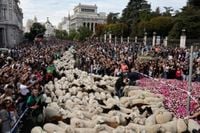On Sunday, October 19, 2025, the bustling streets of Madrid were transformed into a pastoral spectacle as around 1,100 Merino sheep and 200 goats made their way through the Spanish capital, captivating thousands of onlookers. The annual Transhumance Festival, a vibrant celebration of rural heritage, once again brought together shepherds, animals, and city dwellers in a unique pageant that harkens back to centuries-old traditions.
This was no ordinary traffic jam. Instead of honking cars and hurried commuters, the city center echoed with the sounds of bells, bleating sheep, and lively horn music. According to the Associated Press, the event saw shepherds, many dressed in traditional regional costumes, guiding their flocks along ancient migration routes that predate the city itself. These routes, known as droving paths, once threaded through open fields and woodlands, forming a vast network across the Iberian Peninsula.
The Transhumance Festival, held annually since 1994, is more than just a nostalgic nod to the past. Organizers and participants use the occasion to defend ancient grazing and migration rights—rights that are increasingly threatened by Madrid’s relentless urban sprawl and the rise of modern agricultural practices. As reported by AP photo editors, the event is a vivid reminder of a time when livestock movements shaped both the landscape and the livelihoods of rural Spaniards.
But there’s more to the festival than tradition alone. The ecological benefits of transhumance—seasonal movement of livestock between pastures—are at the heart of the celebration. Traditional grazing helps clear brush and flammable undergrowth, a natural method of reducing the risk of wildfires that have become an ever-growing threat in Spain. This summer, the country faced one of its most destructive wildfire seasons in recorded history, a fact that environmentalists like Juan Garcia Vicente say underscores the urgency of preserving these age-old practices. "We have to fight this along several fronts," Vicente told the Associated Press, highlighting both the dangers of climate change and the "total abandonment of the rural world" in Spain.
The festival’s roots stretch deep into Madrid’s history. The city sits atop an ancient migration corridor that shepherds have used for centuries to move their animals between summer and winter grazing lands. In a symbolic gesture, organizers pay the city a fee in medieval coins—50 maravedis—to secure safe passage for their flocks. This tradition dates back to a 1418 agreement between the city and local shepherds, a testament to the enduring relationship between Madrid and its rural hinterlands.
For many, the festival is a cherished spectacle. Locals and tourists alike pack the city’s iconic squares, such as Puerta del Sol, to witness the unusual procession. Ana Vasquez, a Madrid resident who attended this year’s event with her husband, summed up the sentiment for AP: "It's another traditional festival. It recalls another era, and, well, it's nice." Others, like American tourist Jennifer Granda, find the event both novel and meaningful: "It's a very interesting concept. We appreciated the idea that they're promoting agriculture."
The festival is not just about sheep and goats, though their numbers—over a thousand strong—are impressive. It’s a living tableau, with shepherds and their families donning colorful regional attire, and even baby goats being carried through the crowds. The parade is punctuated by music, laughter, and the occasional pause as the animals graze on patches of grass along the route. For a few hours, the city’s modern rhythm gives way to the gentle pace of rural life.
This year’s festival was especially poignant. Last year, the event was canceled due to concerns about a bluetongue disease variant, a reminder of the vulnerabilities that traditional farming faces in the modern era. According to The Korea Herald, the absence of the festival in 2024 was keenly felt by both locals and the small but dedicated community of shepherds who maintain the practice of transhumance. In Spain, modern farming methods have largely supplanted the old ways, leaving only a handful of families to keep the tradition alive—not just for its environmental benefits, but for its cultural significance as well.
Participants in the festival do more than walk sheep through city streets. They defend rights that are centuries old, rights that are now at risk as Madrid continues to expand and as agricultural practices shift toward industrialization. The festival is a living protest, a joyful assertion that rural traditions still matter in an increasingly urbanized world. As shepherds guide their flocks past Madrid’s famous landmarks, they are, in a sense, reclaiming the city for the countryside—if only for a day.
It’s not just Madrid that celebrates this unique blend of heritage and ecology. Similar festivals take place in smaller towns across Italy, France, and even California, where communities recognize the importance of traditional grazing in maintaining healthy landscapes and preventing wildfires. Still, Madrid’s festival stands out for its scale and its setting: a major European capital temporarily transformed into a rural crossroads.
The spectacle also serves as a reminder of the delicate balance between progress and preservation. As urban areas grow and technology reshapes the countryside, the ancient practice of transhumance faces an uncertain future. Yet, as thousands of people line the streets to cheer on the shepherds and their flocks, it’s clear that there is still a deep appreciation for the rhythms of rural life—and a recognition that some traditions are worth keeping alive.
As the last of the sheep and goats made their way out of central Madrid, the city slowly returned to its usual hustle and bustle. But for those who witnessed the parade, the memory of bells, bleats, and a living river of wool and horns will linger—an annual reminder that the past is never as far away as it seems, and that the countryside still has a place in the heart of the city.




